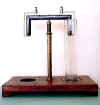
 SM215
Thermocouple
circa 1940 Heat
SM215
Thermocouple
circa 1940 Heat
In 1821, Seebeck found that by heating one of the junctions of a
bimetallic circuit, an electric current is produced.
Metals form a thermo-electric series by producing different
coefficients of emf with temperature with respect to lead as a
reference.
For example, Bismuth is +97μV with Nickel +22μV and tin
and Copper being
–1μV.
The coefficient of Silver is
-2.5μV and that of Antimony is
-25μV.
The best combination of materials found empirically for producing
the highest emf is Bismuth and Antimony and the combination is used in
the thermopile, which consists of a large number of these junctions in
series.
In an attempt to produce electrical energy directly from heat, a rod of
bismuth is produced in a twice-bent form and copper is used as the other
metal forming the junctions.
This assembly can be seen as SM215.
If one of the junctions is kept in ice water and the other in
boiling water, an emf of 0.01 Volts is produced and the current can be
large since there is a low electrical resistance.
Several of these can be connected in series to form a
thermo-electric battery.
The conversion efficiency of such a battery is found to be very
low (about 1%).

![]()
 Museum
Museum
![]()
 SM215
Thermocouple
SM215
Thermocouple![]()